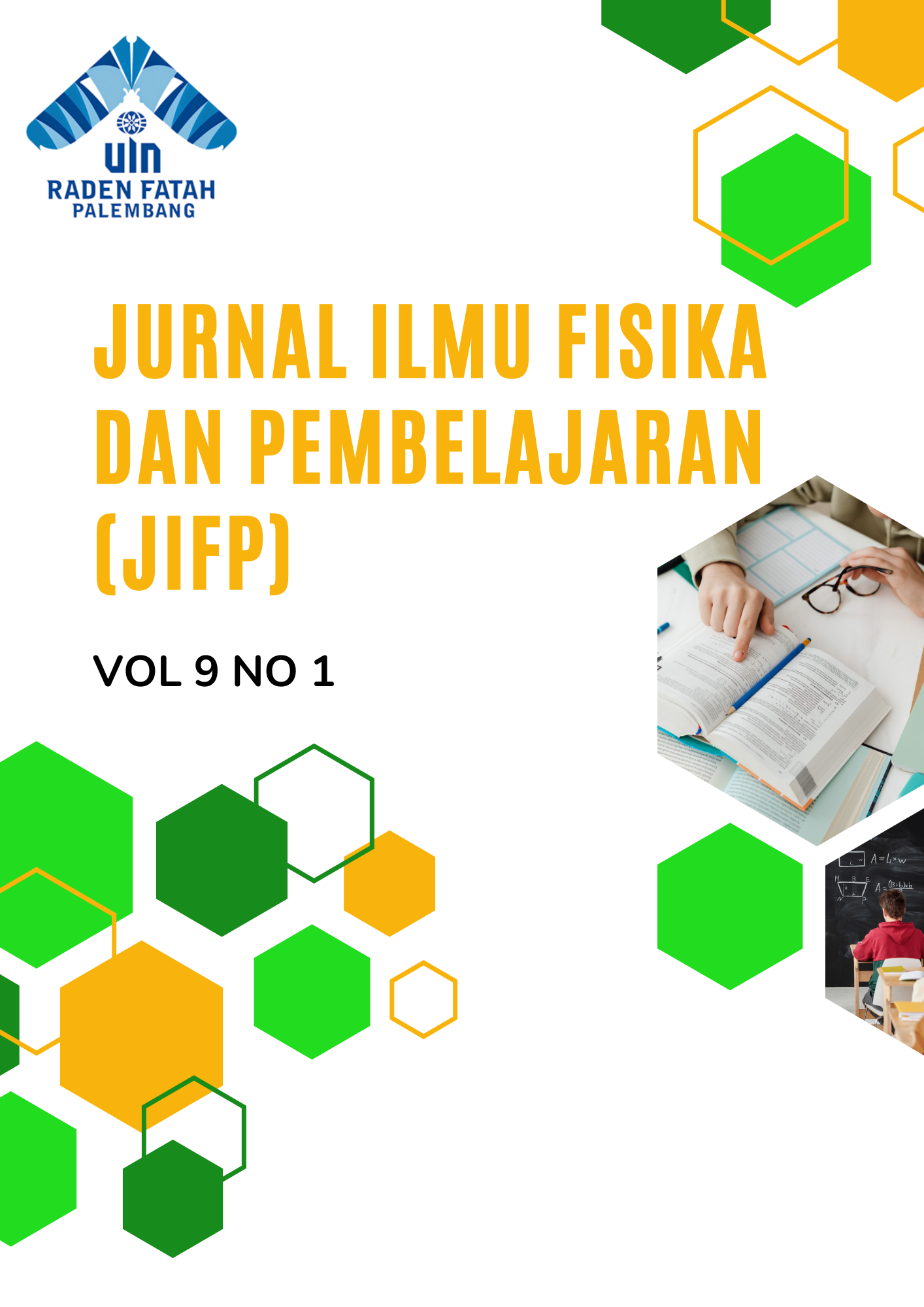CORRELATION ANALYSIS OF LIGHT INTENSITY ON THE EFFICIENCY AND PHOTOCURRENT RESPONSIVITY OF SOLAR PANELS IN BENGKULU CITY
Main Article Content
Abstract
The efficiency of solar panels is generally influenced by the installation tilt angle, as it affects the amount of sunlight absorbed and the detector's response in converting light intensity into electrical energy. This study aims to analyze the relationship between light intensity, efficiency, and photocurrent responsivity of monocrystalline solar panels based on experimental data collected in Bengkulu City. The research method employed correlation and linear regression analysis to evaluate the relationships between light intensity, efficiency, and photocurrent responsivity at tilt angles of 0°, 30°, and 60°. The results indicate that the highest efficiency of 15% was achieved at a 0° tilt, even though the highest light intensity of 146,467 lux occurred at a 60° tilt. The relationship between light intensity and efficiency is nonlinear, although a positive correlation was observed, with the highest regression coefficient of 0.0000006x and the highest coefficient of determination (R²) of 39.19% found at a 30° tilt. Conversely, the relationship between light intensity and photocurrent responsivity exhibited a negative correlation, with the highest regression coefficient of –0.0000001x and the highest R² of 25.98% at a 60° tilt. These findings suggest that the linear relationship between light intensity and both efficiency and photocurrent responsivity is relatively weak, likely due to other dominant factors affecting the performance of the solar panel
Downloads
Article Details
How to Cite
References
Abdurahman, Rosiana, E., Setiawan, J., & Fauzi, W. P. (2023). Analisa Pengaruh Sudut Kemiringan Terhadap Efisiensi Fotovoltaik pada PLTS UNiversitas Pamulang Viktor. EPIC (Journal of Electrical Power, Instrumentation and Control), 6(2), 169-178. doi: 10.32493/epic.v6i2.36263
Anoi, Y. H., Yani, A., & Yunanri, W. (2019). Analisis Sudut Panel Solar Cell terhadap daya ouput dan efisiensi yang dihasilkan. TURBO, 8(2), 177-182.
Hamdani, M., Sari, D., Susanti, & Tiandho, Y. (2021). Pengaruh Jarak, Kemiringan, dan Intensitas Cahaya pada Analisis Ukuran Pori Masker Kain Menggunakan Smartphone. JOP (Journal Online Of Physics), 7(1), 26-30. doi:https://doi.org/10.22437/jop.v7i1.14502
Hertkorn, D., Megnin, C., Muller, c., Hanemann, T., & Reinecke, H. (2017). Light intensity influence on strontium Titanate based photo-electrochemical cells. Ceramics-Silikaty, 61(3). doi:10.13168/CS.2017.0014
Ishii, T., Otani, K., Takashima T, & Xue, Y. (2011). Solar spectral influence on the performance of photovoltaic (PV) modules under fine weather and cloudy weather conditions. Progress in Photovoltaics, 21(4), 481-489. doi:10.1002/PIP.1210
Islam, M. A., Kasim, N. M., Alkahtani, A. A., & Amin, N. (2022). Assessing the Impact of Spectral Irradiance on the Performance of Different Photovoltaic Technologies. IntechOpen. doi: 10.5772/intechopen.96697
Liu, M., Endo, M., Shimazaki, A., Wakamiya, A., Tachibana, Y., & Tachibana, Y. (2017). Light Intensity Dependence of Performance of Lead Halide Perovskite Solar Cells. Journal of Photopolymer Science and Technology, 30(5), 577-582. doi:10.2494/PHOTOPOLYMER.30.577
Mardani, R., Gusa, R. F., & Sunanda, W. (2022). Pengaruh Sudut Kemiringan Terhadap Unjuk Kerja Panel Surya (Studi di Univeristas bangka Belitung). Jurnal Ilmiah Setrum, 11(1), 90-97.
Marpaung, M. D., & Purba, J. S. (2024). Analisis Pengaruh Variasi Sudut Kemiringan Panel Surya Untuk Pemanas Air dengan Sumber Energi Surya. Jurnal Media Informatika (JUMIN), 6(1), 71-82.
Pekkola, O., Lungenschmied, C., Fejes, P., Handreck, A., Hermes, W., Irle, S., . . . Bruder, I. (2018). Focus-Induced Photoresponse:a novel way to measure distance with photodetectors. Scientific Reports (Sci Rep), 8(9208). doi:10.1038/s41598-018-27475-1
Rauer, M., Fell, A., Wohler, W., Hinken, D., REichal, C., Bothe, K., . . . Hohl-Ebinger, J. (2024). The Impact of Measurement Conditions on Solar Cell Efficiency. Solar RRL, 8(3). doi:10.1002/solr.202300873
Ridho, D. A., Rusda, & Putra, M. A. (2023). Analisis Pengaruh Sudut Kemiringan Panel Surya Terhadap Penerimaan Iradiasi Matahari dan Daya Keluaran yang dihasilkan. PoliGrid, 4(1), 25-31. doi:https://doi.org/10.46964/poligrid.v4i1.18
Sarmah, P., Das, D., Saikia, M., Kumar, V., Yadav, S. K., Paramasivam, P., & Dhanasekaran, S. (2023). Comprehensive Analysis of Solar Panel Performance and Correlations with Meteorological Paramaters. ACS Omega, 8(50), 47897-47904. doi:10.1021/acsomega.3c06442
Sartono, N. P., Ridwan, E., & Ridlwan, H. M. (2021). Pengaruh Perbedaan Posisi Sudut Kemiringan Panel Surya 120 Watt Peak Terhadap Peningkatan Efisiensi. Prosiding Seminar Nasional Teknik Mesin PNJ (hal. 246-253). Jakarta: Politeknik Negeri Jakarta.
Sugiono, F. A., Larasati , P. D., & Kurniawan , E. A. (2022). Pengaruh Sudut Kemiringan Panel Surya Terhadap Potensi Pemanfaatan PLTS Rooftop di Bengkel Teknik Mesin, Politeknik Negeri Semarang. Jurnal Rekayasa Energi (JRE), 1(1), 1-8.
Zyoud, A. H. (2024). Influence of light Intensity on The Performance of CdS thun-Film Photoelectrochemical Cells. J Mater Sci: Mater Electron, 35(1879). doi:10.1007/s10854-024-13664-4

